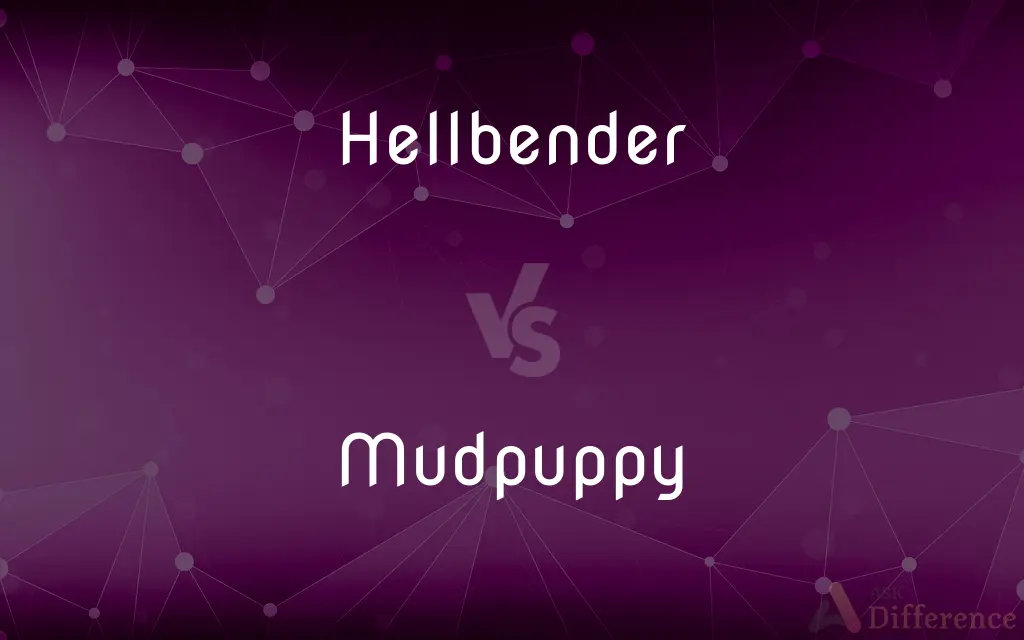Hellbender vs. Mudpuppy — What's the Difference?
By Maham Liaqat & Fiza Rafique — Updated on April 9, 2024
Hellbenders are large aquatic salamanders native to eastern North America, known for their wrinkled skin and solitary nature. Mudpuppies are smaller, gilled salamanders found in lakes and rivers, notable for their external gills and more social behavior.

Difference Between Hellbender and Mudpuppy
Table of Contents
ADVERTISEMENT
Key Differences
Hellbenders, one of the largest types of salamanders, are distinguished by their flat bodies, folded skin, and adaptations for a solitary, bottom-dwelling lifestyle in fast-flowing freshwater environments. Their physical appearance is designed to blend with the rocky riverbeds where they live, aiding in camouflage. On the other hand, mudpuppies are smaller and retain their external gills throughout their lives, a feature that gives them a distinctive, frilly appearance. They inhabit slower-moving waters and are more commonly observed in groups, reflecting a less solitary lifestyle compared to hellbenders.
While hellbenders rely on their skin to absorb oxygen, a trait that necessitates clean, well-oxygenated water for their survival, mudpuppies have both lungs and functional external gills, allowing them to thrive in a wider range of aquatic environments, including murkier and less oxygenated waters. This difference in respiratory adaptations underscores the hellbender's vulnerability to pollution and habitat degradation.
The diet of a hellbender primarily consists of crayfish, supplemented by small fish and invertebrates, reflecting their role as apex predators within their ecosystem. Mudpuppies, with a more varied diet, consume insects, small fish, and other aquatic organisms, indicating a broader ecological niche. This difference in feeding habits points to the hellbender's specialized role in their habitat, whereas mudpuppies have a more generalized lifestyle.
Reproduction in hellbenders involves the male guarding a nest where the female lays her eggs, highlighting a unique aspect of parental care not observed in many amphibian species. Mudpuppies, conversely, have less distinctive breeding behaviors, with external fertilization and no extended parental care, illustrating divergent reproductive strategies that reflect their differing ecological adaptations.
Despite these differences, both species play crucial roles in their respective ecosystems as indicators of water quality and biodiversity. Their presence and health in aquatic environments serve as valuable indicators for conservationists monitoring ecosystem health and water quality.
ADVERTISEMENT
Comparison Chart
Size
Larger, up to 29 inches long
Smaller, typically up to 13 inches long
Habitat
Fast-flowing, clean freshwater rivers and streams
Lakes, rivers, and streams with slow to moderate flow
Appearance
Wrinkled skin, lack of external gills, camouflage color
External gills, smooth skin, adapted to murkier waters
Behavior
Solitary, secretive, bottom-dwelling
More social, can be found in groups, less reclusive
Respiration
Skin absorption in highly oxygenated water
External gills and lungs, adaptable to various oxygen levels
Diet
Primarily crayfish, some small fish and invertebrates
Insects, small fish, and aquatic organisms
Reproduction
Male guards nest where eggs are laid
External fertilization, no extended parental care
Conservation Status
Sensitive to pollution and habitat degradation
More adaptable but still affected by environmental changes
Compare with Definitions
Hellbender
Solitary and bottom-dwelling, preferring fast-flowing streams.
Hellbenders spend most of their life hidden under rocks in rivers.
Mudpuppy
A smaller, gilled aquatic salamander found in North American lakes and rivers.
Mudpuppies are unique for retaining their external gills throughout life.
Hellbender
Characterized by wrinkled skin and a lack of external gills.
Hellbenders breathe through their skin, requiring pristine, oxygen-rich waters.
Mudpuppy
Eats a varied diet of insects, small fish, and aquatic organisms.
The diverse diet of mudpuppies includes small invertebrates and fish larvae.
Hellbender
A large aquatic salamander native to eastern North America, known for its secretive nature.
The hellbender, due to its need for clean water, serves as an indicator of river health.
Mudpuppy
Known for their external gills and social behavior.
Mudpuppies can often be seen in groups, especially in winter.
Hellbender
Sensitive to environmental changes and pollution.
Conservation efforts are crucial for maintaining hellbender populations.
Mudpuppy
Inhabits a variety of freshwater environments.
Mudpuppies are adaptable, living in both clear and murky waters.
Hellbender
Primarily feeds on crayfish.
Hellbenders help control crayfish populations in their habitats.
Mudpuppy
Less affected by pollution compared to hellbenders.
Mudpuppies, with their gills and lungs, can tolerate a wider range of water qualities.
Hellbender
The hellbender (Cryptobranchus alleganiensis), also known as the hellbender salamander, is a species of aquatic giant salamander endemic to the eastern and central United States. It is the largest salamander in North America.
Mudpuppy
Any of several large eastern North American aquatic salamanders of the genus Necturus, especially N. maculosus, that have feathery dark red external gills. Also called water dog.
Hellbender
A large aquatic salamander (Cryptobranchus alleganiensis) of the eastern United States, having a flattened brownish body.
Mudpuppy
An aquatic salamander of the family Proteidae.
Hellbender
A giant salamander (genus Cryptobranchus) of North America that inhabits large, swiftly flowing streams with rocky bottoms.
Hellbender
A reckless, headstrong person.
Hellbender
A large North American aquatic salamander (Protonopsis horrida or Menopoma Alleghaniensis). It is very voracious and very tenacious of life. Also called alligator, and water dog.
Hellbender
Large salamander of North American rivers and streams
Common Curiosities
Can hellbenders and mudpuppies live in the same habitat?
While they may share overlapping habitats, hellbenders prefer faster, clearer waters, whereas mudpuppies are more adaptable to a variety of water conditions, including murkier environments.
What makes hellbenders unique among salamanders?
Hellbenders are unique due to their large size, wrinkled skin for oxygen absorption, and solitary, secretive lifestyle in fast-flowing waters.
What challenges do conservationists face in protecting hellbenders and mudpuppies?
Conservationists face challenges such as habitat degradation, pollution, and changing climate conditions, which threaten the survival of these sensitive amphibians.
Why are mudpuppies called that?
Mudpuppies are so named possibly due to the mistaken belief that they make a dog-like barking sound, though they are actually silent.
How do hellbenders breathe?
Hellbenders breathe primarily through their skin, requiring clean, highly oxygenated water to absorb sufficient oxygen.
How do hellbenders and mudpuppies contribute to their ecosystems?
Both species play vital roles in their ecosystems, controlling invertebrate populations, serving as prey for larger predators, and indicating water quality health.
Are mudpuppies good indicators of water quality?
Mudpuppies can tolerate a wider range of water conditions than hellbenders, making them less reliable as indicators of pristine water quality.
What are the conservation statuses of hellbenders and mudpuppies?
Hellbenders are often considered species of conservation concern due to their sensitivity to pollution and habitat degradation, whereas mudpuppies, although adaptable, are also affected by environmental changes and require monitoring.
How can people help in the conservation of hellbenders and mudpuppies?
Supporting clean water initiatives, habitat protection efforts, and raising awareness about the ecological importance of these amphibians can contribute to social culture.
Why are hellbenders sometimes mistaken for dangerous creatures?
Due to their large size and unique appearance, hellbenders can be mistakenly feared as dangerous, though they are harmless to humans and play important ecological roles.
Share Your Discovery

Previous Comparison
Train vs. Educate
Next Comparison
Gunpowder vs. SugarAuthor Spotlight
Written by
Maham LiaqatCo-written by
Fiza RafiqueFiza Rafique is a skilled content writer at AskDifference.com, where she meticulously refines and enhances written pieces. Drawing from her vast editorial expertise, Fiza ensures clarity, accuracy, and precision in every article. Passionate about language, she continually seeks to elevate the quality of content for readers worldwide.














































